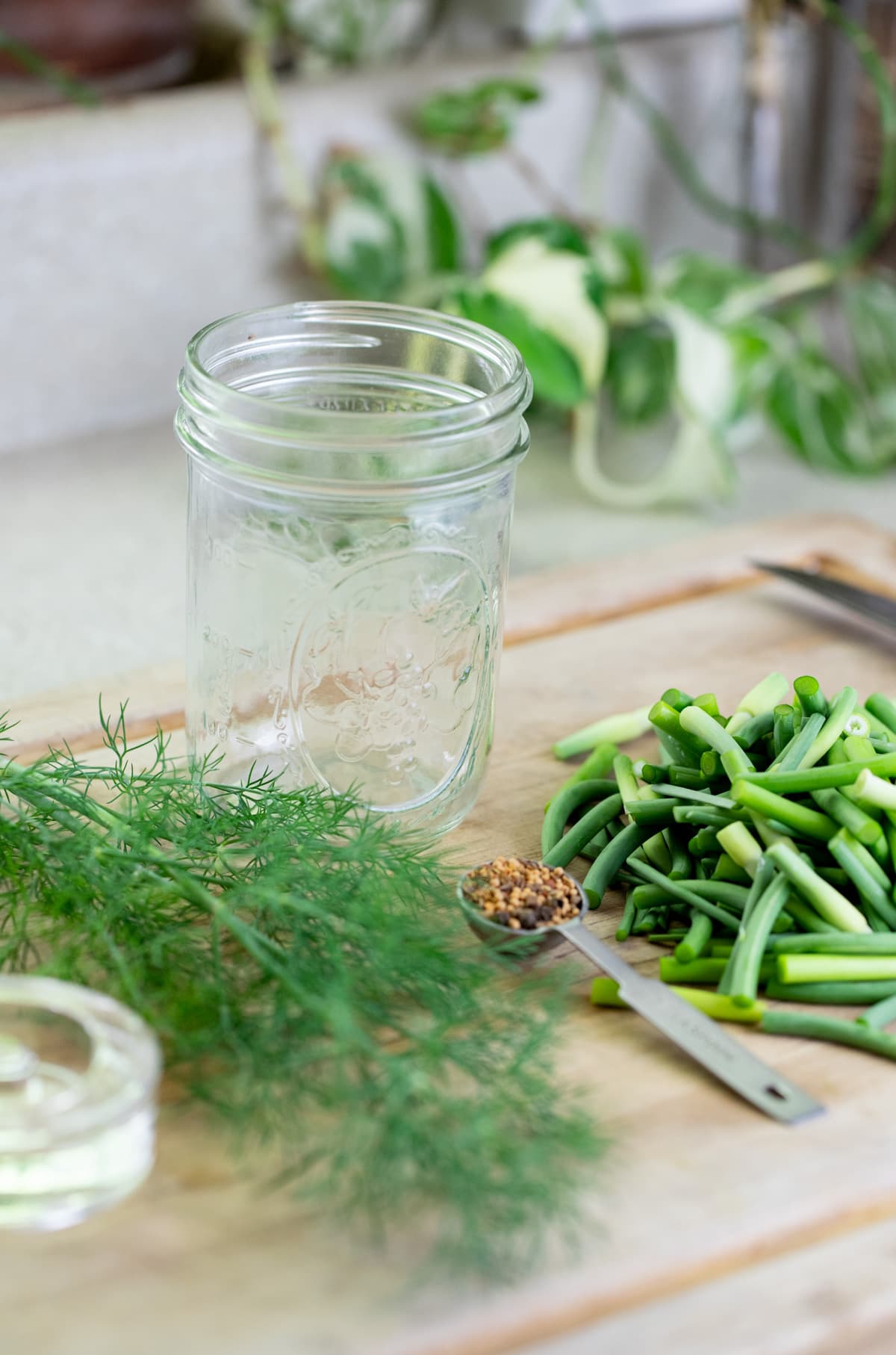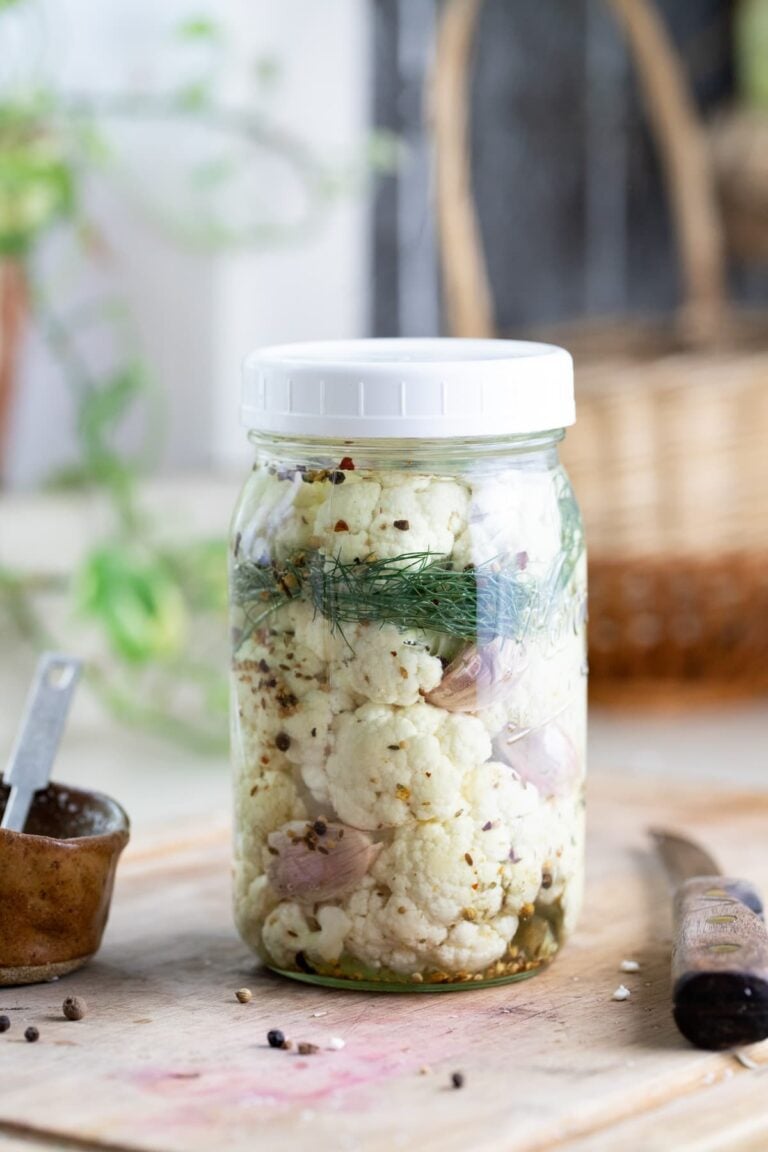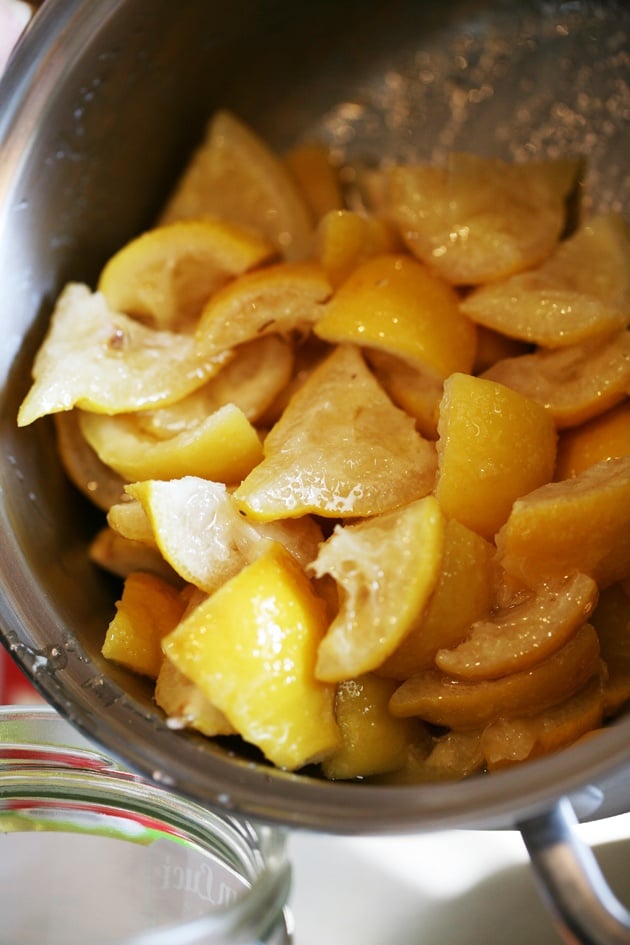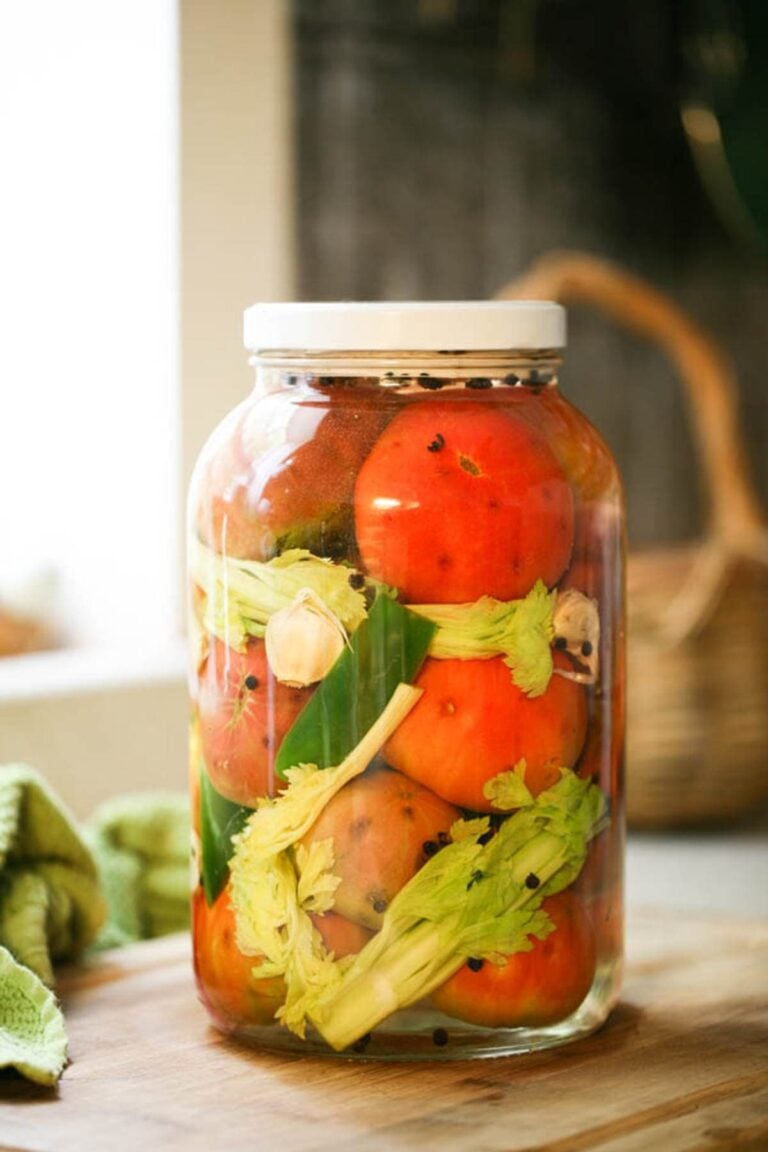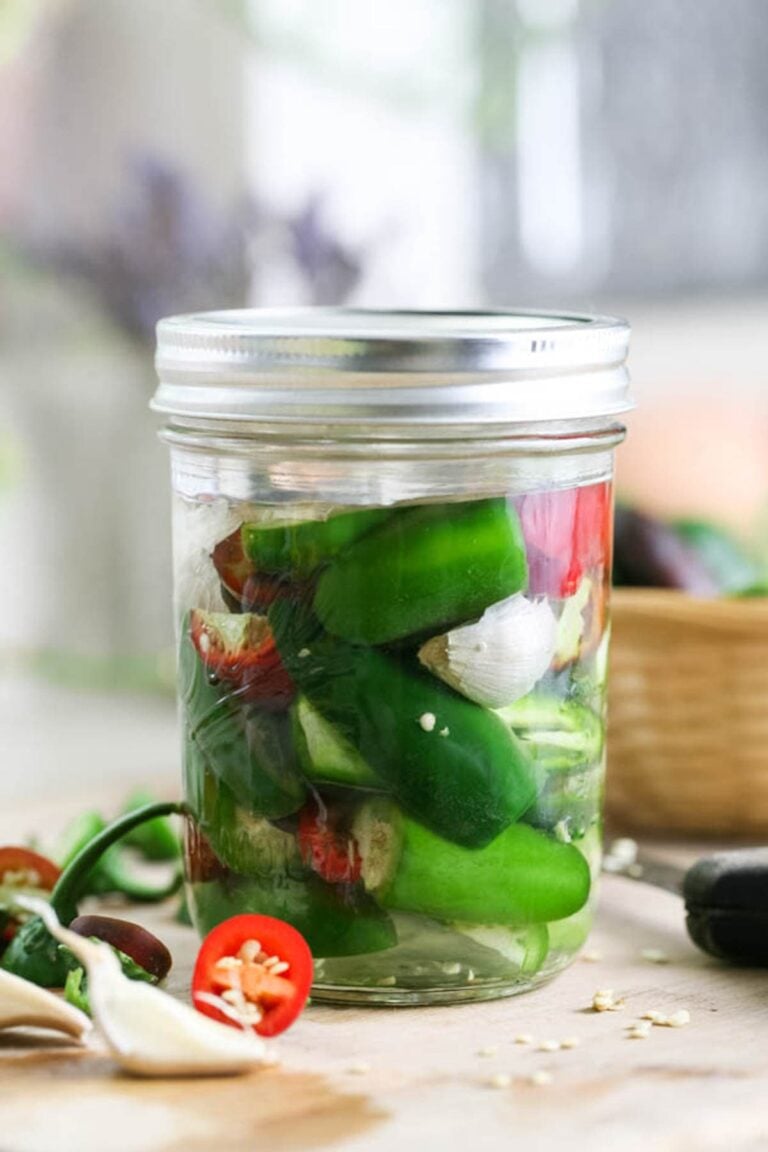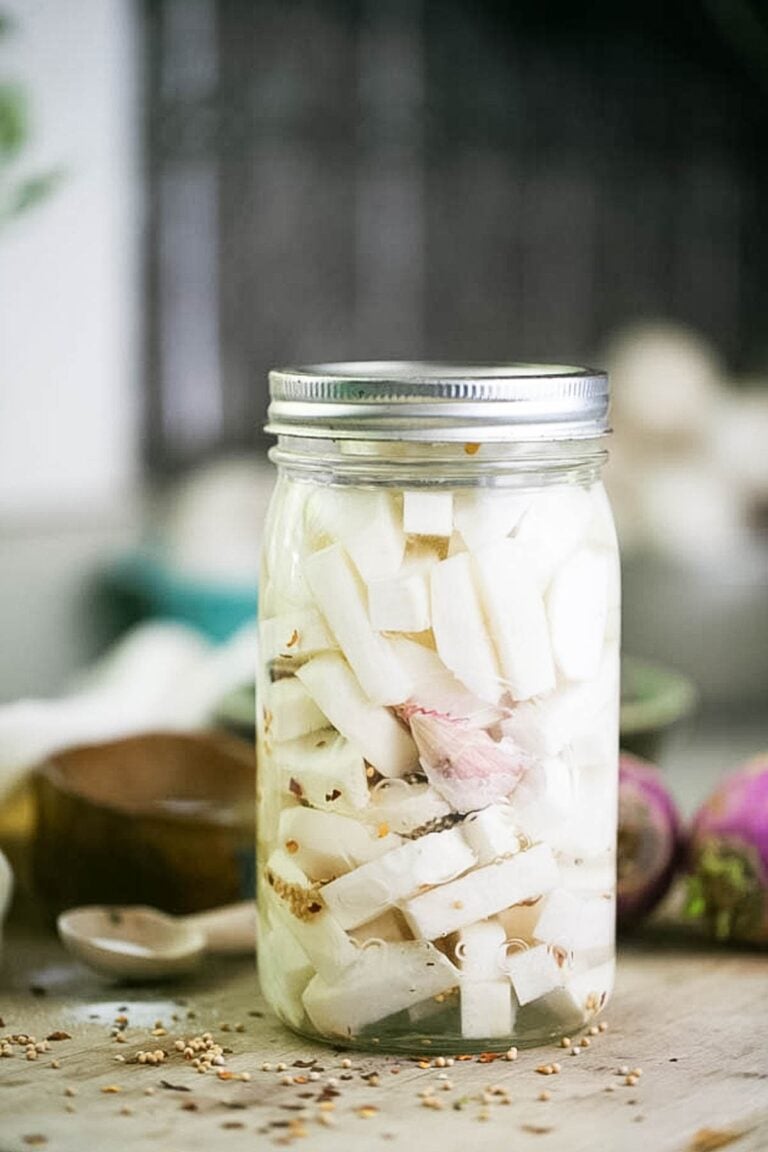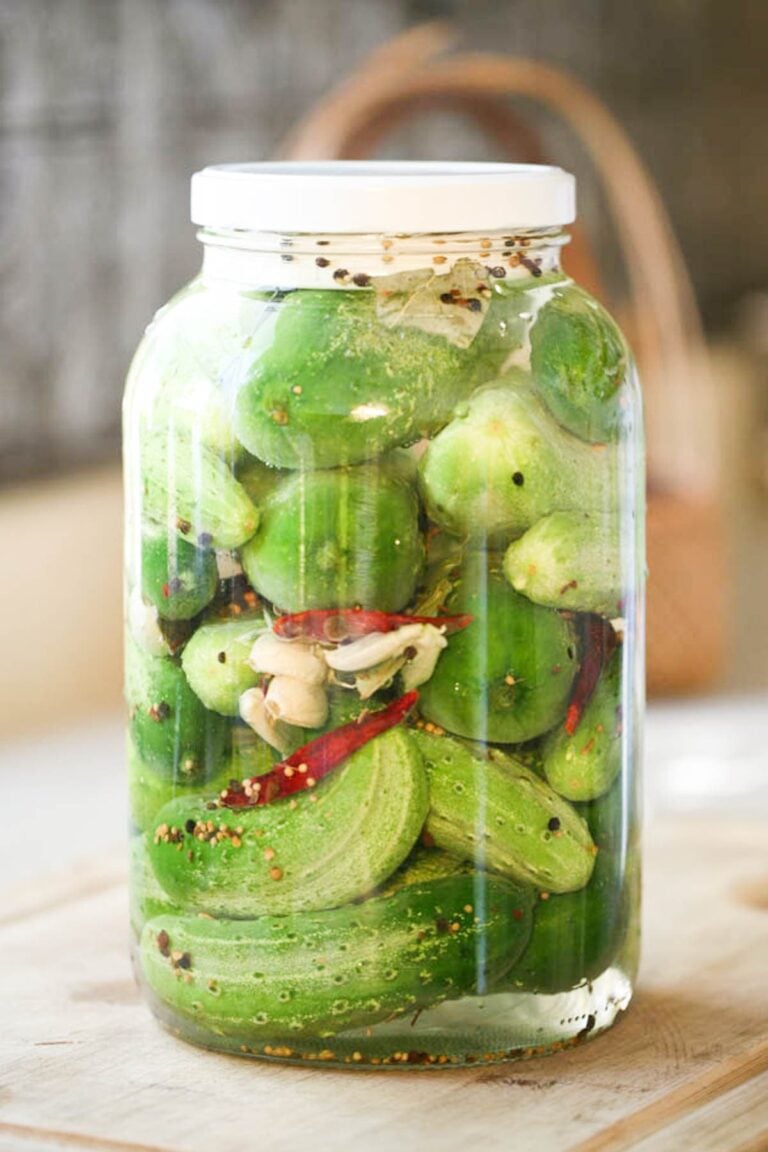Fermented Garlic Scapes
This post may contain affiliate links, view our disclosure policy for details.
Fermented garlic scapes are an easy, healthy, and delicious snack! They can be added as a side to any dish and are a great way to preserve garlic scapes. It takes only a few minutes to put together a jar of these fermented garlic scapes!
Garlic scapes are this premium crop that we eagerly wait for every year! Garlic scapes are the flowering stalk of the garlic plant. We only get one scape per plant and we only get the scapes from hard-neck garlic varieties. Check out this guide on how to grow garlic to learn more.
We harvest the scape about a month before we harvest the garlic bulb. It is fresh, and green, and has that gentle garlic flavor that is absolutely delicious!
Fermented Garlic Scapes…

There are many different things we can do with garlic scapes (check out all the garlic scapes recipes here). In this post, we are going to ferment garlic scapes. Lacto-fermented garlic scapes are very easy to make and they are a delicious side to any meal. We use them a lot as a snack too.
What is Fermentation…
Fermentation is the process of using microorganisms, such as bacteria or yeast, to convert carbohydrates to alcohol or organic acids under anaerobic conditions. There are a couple types of fermentation…
- Alcoholic fermentation is when we use yeast to break down sugars into carbon dioxide and ethanol. This is the process we use to make beer, wine, and bread.
- Lacto fermentation is the process of using bacteria, named Lactobacillus, to convert sugars into lactic acid. This bacteria (some form of it) is actually present in our digestive system naturally and is also present on the surface of plants. Lactic acid is a preservative that helps us preserve foods by preventing the growth of harmful bacteria. Lacto fermentation, which is the process we are going to use to preserve our garlic scapes, also increases the vitamin and enzyme level of the vegetables we ferment.
Adding fermented foods to our diet can help us introduce additional probiotics, or in other words, beneficial bacteria to our digestive system in a natural way. Beneficial bacteria help us digest food and help us support a healthy metabolism.
Ingredients…
- Garlic scapes – I was able to fit about 20 in a pint jar
- Dill – two sprigs or so.
- Ball seasoning mix – about one teaspoon per pint jar.
- For the brine – one teaspoon of sea, Kosher, or canning salt per one cup of non-chlorinated water. For a pint jar, I used 1 ½ cup of brine.
Kitchen Tools…
- Cutting board
- Knife
- Jar with a lid – I use a wide-mouth pint jar but you can also use a quart jar with a wide mouth. Make sure to use a plastic freezer lid or a special fermentation lid.
- Measuring spoon
- 2 cup measuring cup
- Fermentation weight
How to Ferment Garlic Scapes…

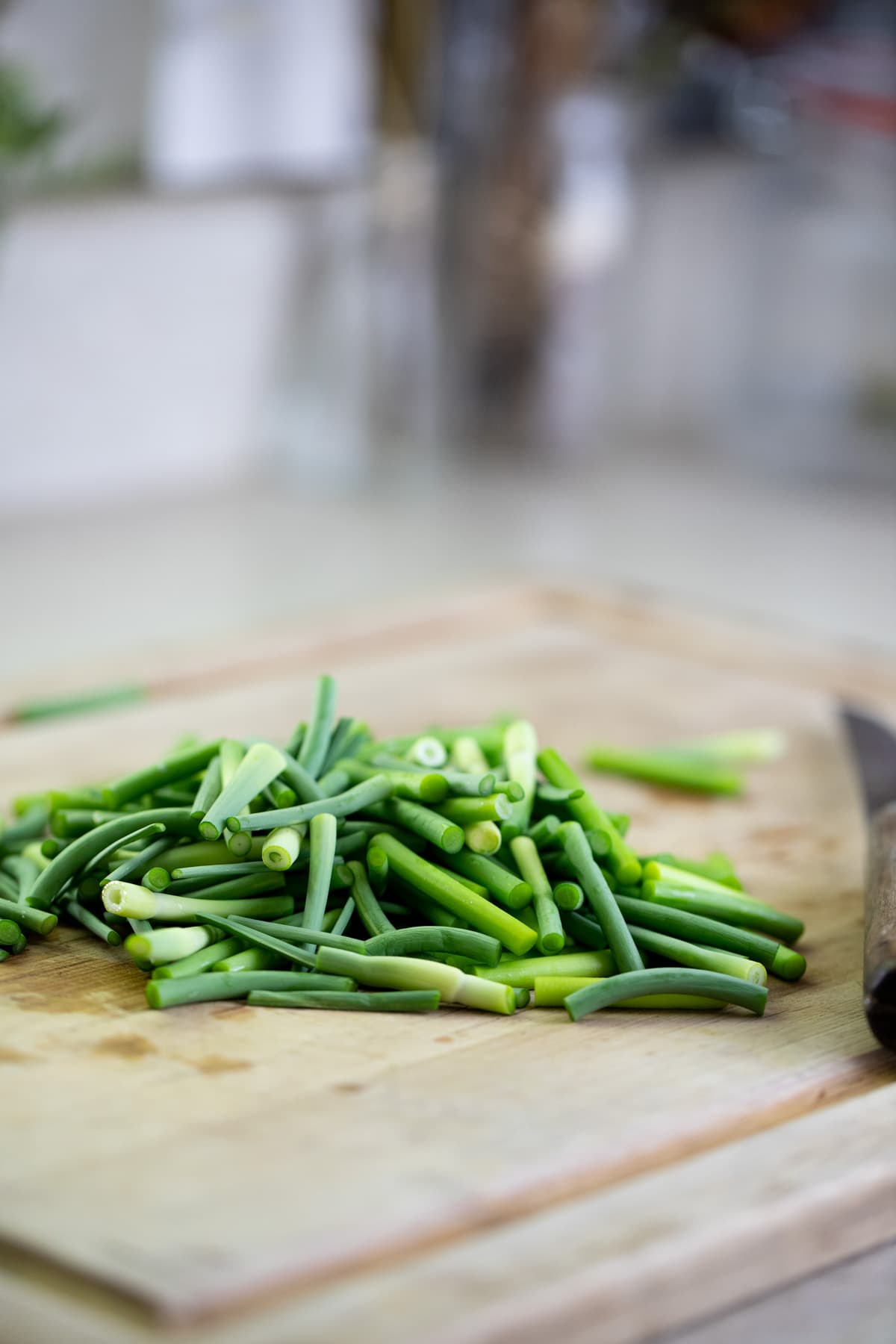
Step one – prep the garlic scapes. Garlic scapes are long and skinny and it’s hard to fit them in a jar or eat them this way. So first, wash your garlic scapes if you need to and dry them. Then, cut them into three-inch pieces.
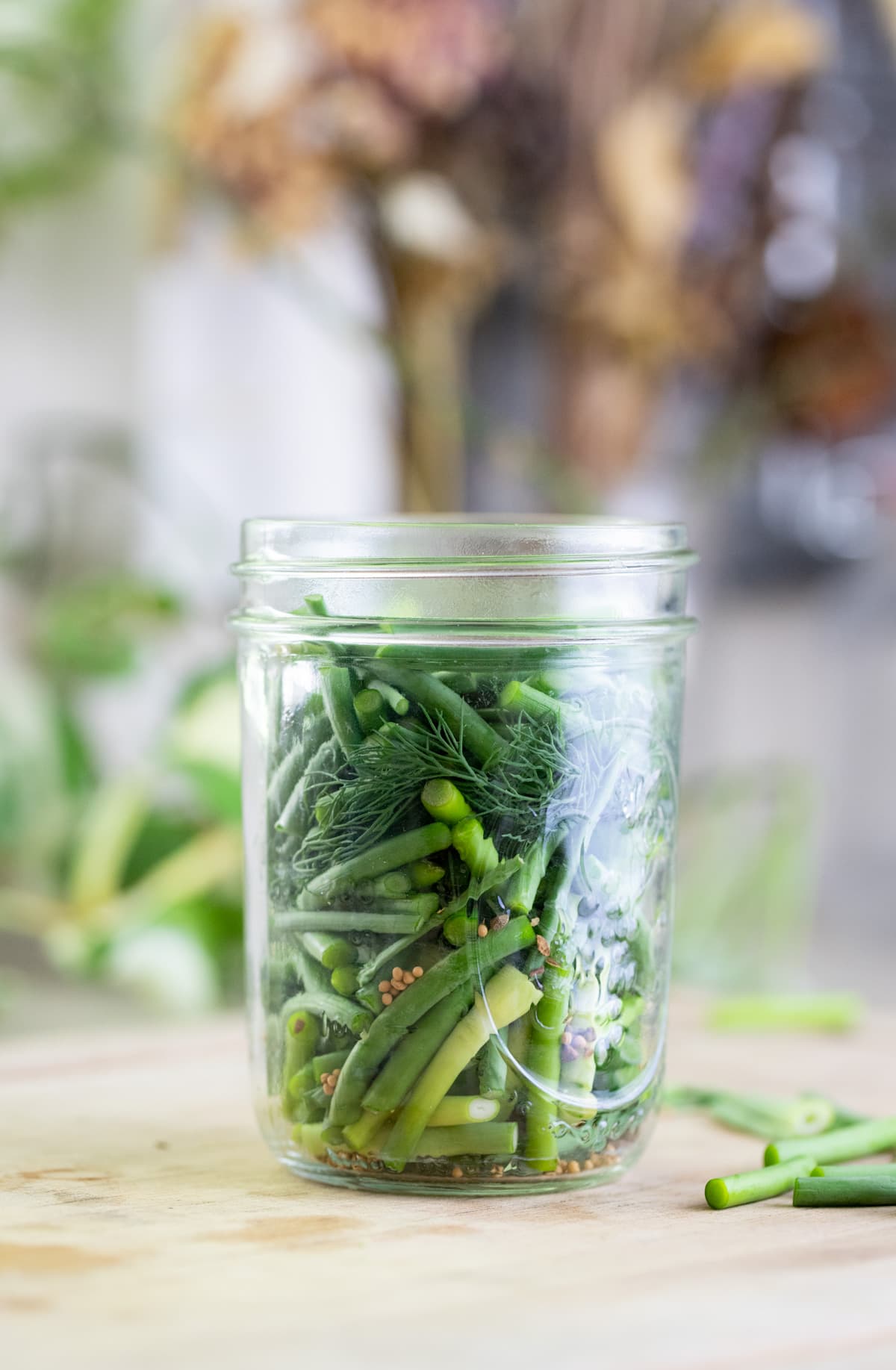
Step two – pack the jar. Wash the jar well with warm water and dish soap, then dry it. Pack the jar with the garlic scapes and in between, add the dill. Make sure to leave about an inch of headspace. Once all the scapes are in the jar add the pickling mix.

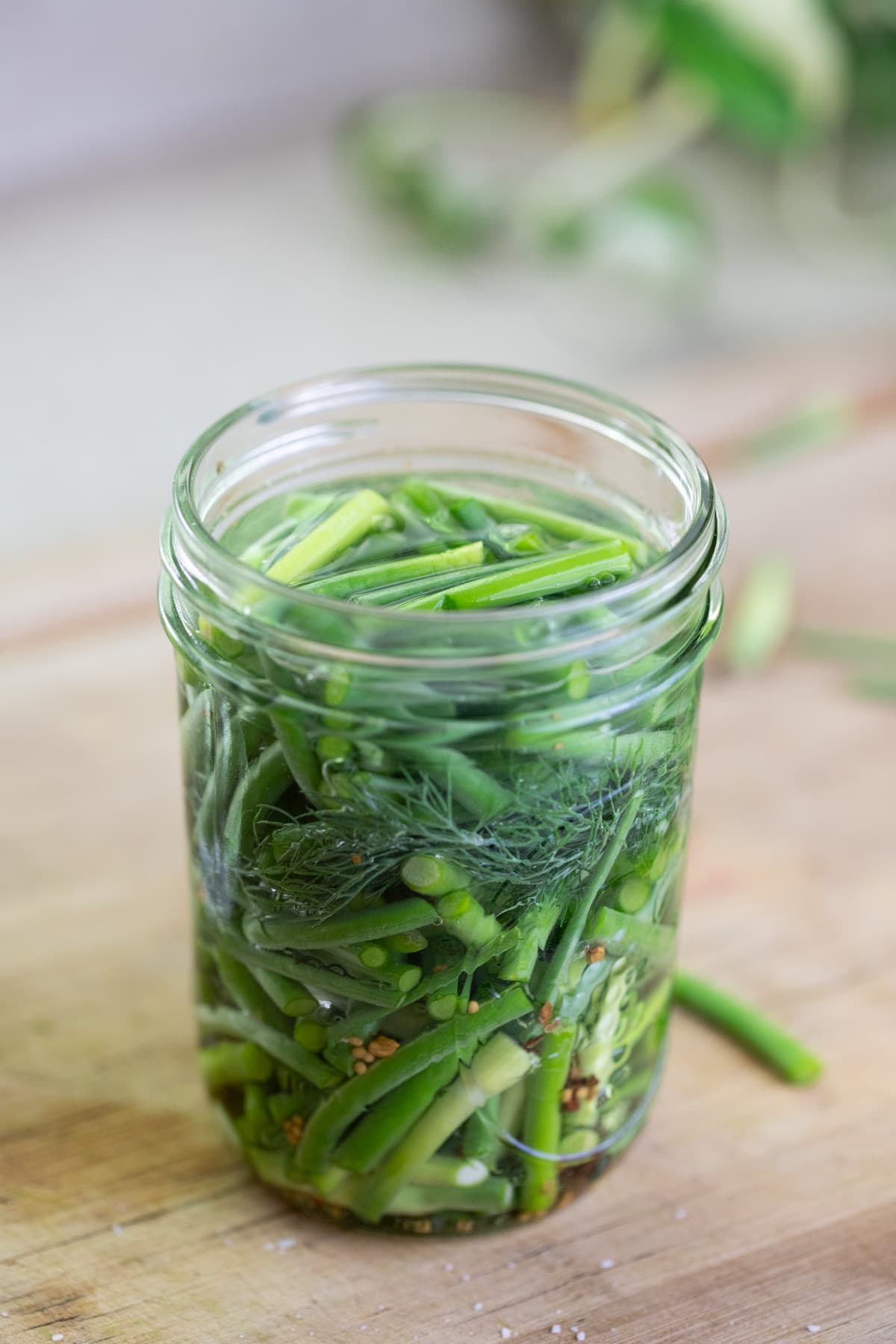
Step three – add the brine. Make the brine by dissolving one teaspoon of salt per one cup of room-temperature water. Add the brine to the jar until it covers the vegetables. It’s important that you use non-chlorinated water. If you live in the city, make sure to use spring water from the store or distilled water. It’s also important that you use non-iodized salt or in other words don’t use table salt. Instead, use kosher, sea, or canning salt.
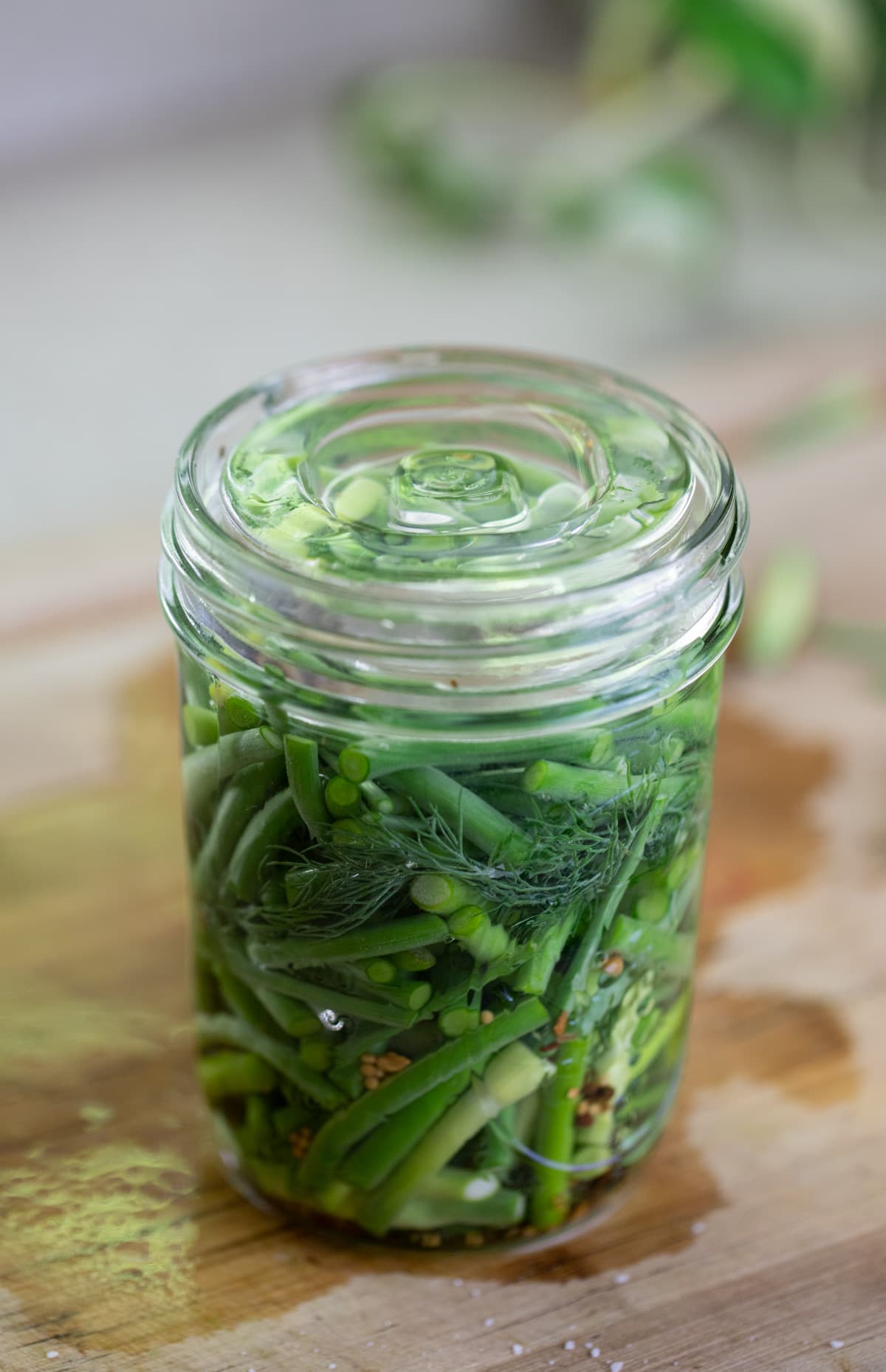
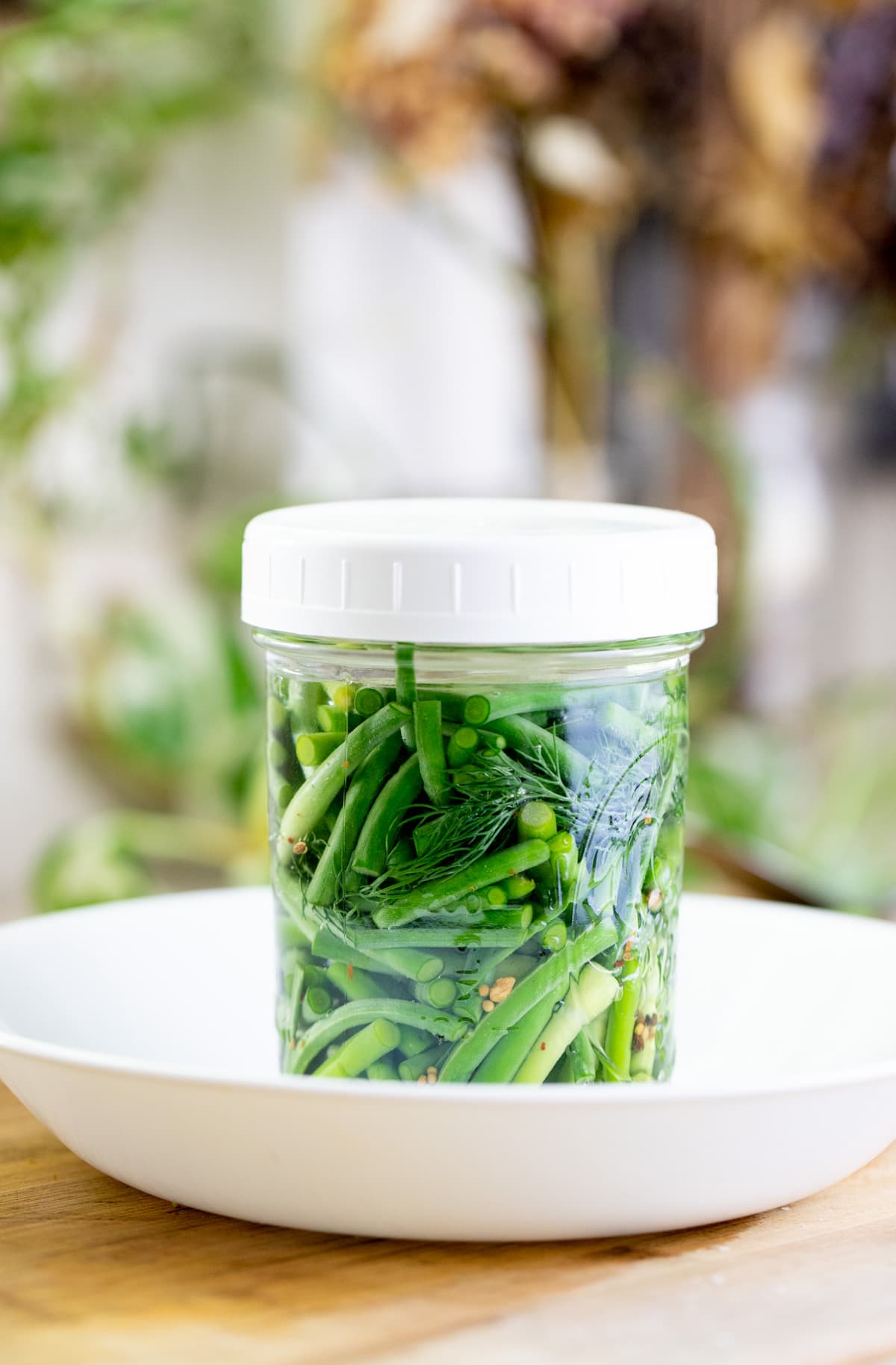
Step four – ferment. Lastly, place the weight on top of the garlic scapes and press them down lightly. Make sure that all the scapes are under the brine. Close the jar with the freezer lid (or a fermentation lid if you are using one), set the jar on a plate (some of the liquid will spill out during the fermentation process, the plate will help you catch the mess), and place the jar on the kitchen counter at room temperature to ferment.
After a couple of days, you’ll notice some bubbles forming at the top of the jar and the brine will start to look foggy. That’s great, this is how you know that the process of fermentation is on its way.
Remember that if you are not using a special lid for fermentation you will have to “burp” the jar, meaning once a day you’ll need to twist the lid open (don’t lift it) for a couple of seconds before twisting it back. This will let the gases that form inside the jar during the fermentation process a way to escape.
A pint or quart jar will probably take 5-7 days to ferment. Usually, I tell people that you’ll know when the fermentation process has been completed because the brine will clear again. It’s never as clear as it is when we add it to the jar but it is noticeably clearer.

How to Store Fermented Garlic Scapes…
- At room temperature – it is possible to leave the jar at room temperature as long as you make sure that the garlic scapes are under the brine. Take into consideration that the scapes are going to soften quickly though. So I say, if you leave the jar at room temperature, use the fermented scapes within three weeks or so.
- In cold storage – the best way to store your fermented garlic scapes is in cold storage (40-45 degrees F). This can be in the fridge or a root cellar. Make sure that the scapes stay under the brine even while the jar is in cold storage and use a clean fork to scoop the scapes out when you are ready to enjoy them. Fermented garlic scapes should easily last 6-8 months in cold storage.
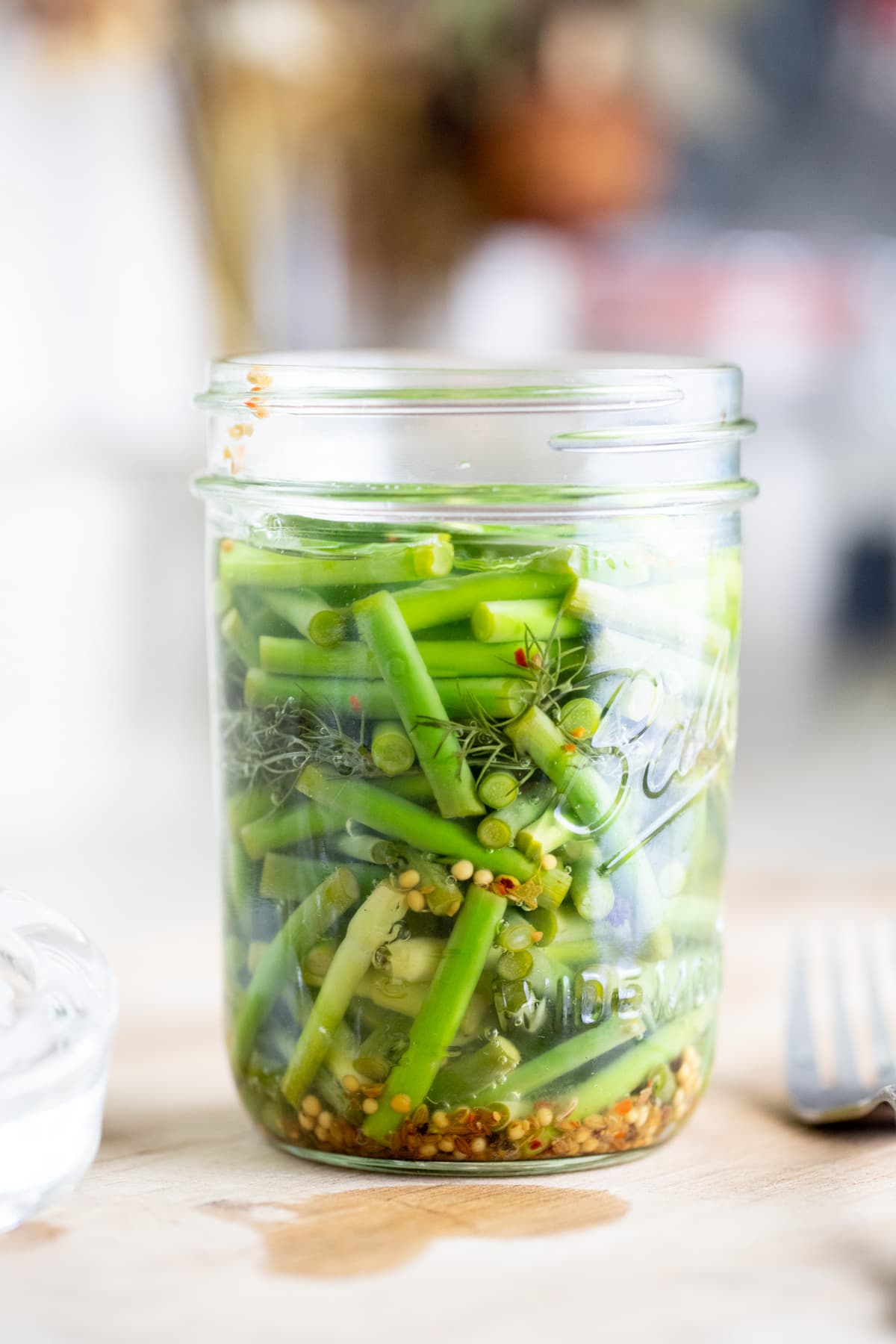
How to Serve Fermented Garlic Scapes…
- As a snack – they are firm and earthy and salty. I love scooping a few scapes into a bowl and snacking on them. It’s so much better than reaching for a cookie or chips.
- As a side – fermented garlic scapes are a great side for an easy sandwich lunch. Add them as a side to a burger instead of the fries, add them as a side to a meat wrap, or a BBQ sandwich or any other.
Add them as a side to this Mediterranean zucchini casserole, or serve them with zucchini and corn fritters for a simple vegetarian lunch or breakfast. - Throw them in salads – they are a delicious, salty addition to any salad. I sometimes add them to my favorite Mediterranean egg salad or a classic Israeli salad.
Frequently Asked Questions…
You can spice fermented garlic scapes however you want. Try adding, cumin, chili flakes, paprika, dry hot peppers or anything else you can come up with.
Yes! You can add pretty much any other vegetable you’d like to try. Some that work well are carrots, peppers, cabbage, beets, radishes, or turnips. Make sure to peel carrots, beets, or similar vegetables. Their skin contains bacteria that might mess up the fermentation process.
If you notice a white film forming on top of the brine don’t worry! The white film is kahm yeast and is not harmful. It develops when the sugars are used up and the pH of the ferment drops because of the lactic acid formation. Simply scoop it out when the ferment is done. More will develop but just scrape it off when you’re ready to eat your fermented garlic scapes.
If your ferment develops raised and fuzzy black, pink, green, or blue mold throw it out. Be sure to clean all the utensils and vessels well.
Garlic scapes are a very special crop! They are delicious lacto-fermented. If you harvest some or can find some at the farmer’s market I hope that you’ll give this recipe a try! It’s delicious, healthy, a great way to preserve garlic scapes, and really easy to put together.
More Garlic Scape Recipes…
- Garlic Scape Pesto
- Roasted garlic Scapes
- Pickled Garlic Scapes
- Dehydrating Garlic Scapes
- Freezing Garlic Scapes
More Fermenting Tutorials…
- Fermenting Turnips
- Fermented Green Tomatoes
- Fermenting Tomatoes Step By Step
- Fermented Jalapenos
- Preserving Peppers in Vinegar and Salt
- Preserving Whole Lemons
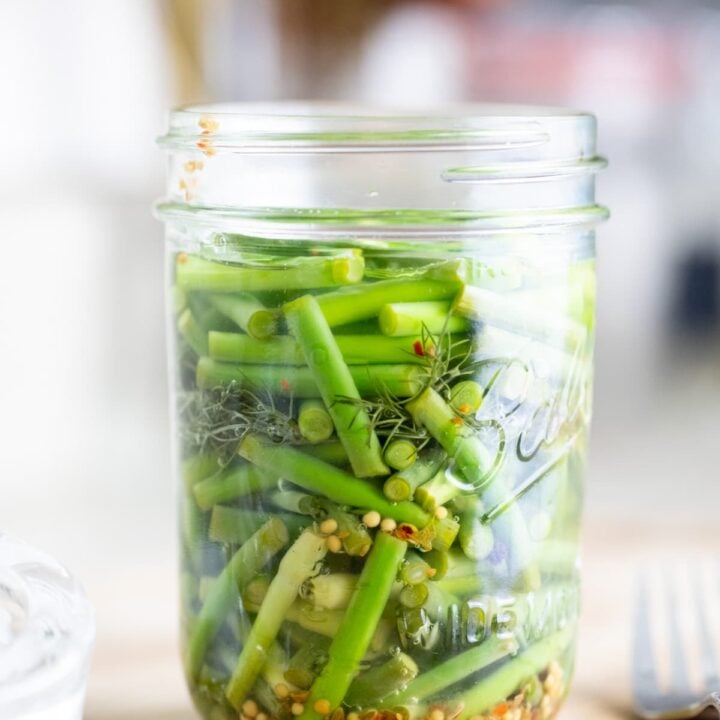
Fermented Garlic Scapes
Very simple lacto-fermented garlic scape recipe.
Ingredients
- 20 garlic scapes
- 2 sprigs of dill
- 1 teaspoon of Ball pickling mix
- For the brine – one teaspoon of sea, Kosher, or canning salt per one cup of non-chlorinated water. For a pint jar, I used 1 ½ cup of brine.
Instructions
- Wash your garlic scapes if you need to and dry them. Then, cut them into three-inch pieces.
- Wash the jar well with warm water and dish soap, then dry it. Pack the jar with the garlic scapes and in between, add the dill. Make sure to leave about an inch of headspace. Once all the scapes are in the jar add the pickling mix.
- Make the brine by dissolving one teaspoon of salt per one cup of room-temperature water. Add the brine to the jar until it covers the vegetables.
- Lastly, place the weight on top of the garlic scapes and press them down lightly. Make sure that all the scapes are under the brine. Close the jar with the freezer lid (or a fermentation lid if you are using one), set the jar on a plate (some of the liquid will spill out during the fermentation process, the plate will help you catch the mess), and place the jar on the kitchen counter at room temperature to ferment.
After a couple of days, you’ll notice some bubbles forming at the top of the jar and the brine will start to look foggy. That’s great, this is how you know that the process of fermentation is on its way.
Remember that if you are not using a special lid for fermentation you will have to “burp” the jar, meaning once a day you’ll need to twist the lid open (don’t lift it) for a couple of seconds before twisting it back. This will let the gases that form inside the jar during the fermentation process a way to escape.
A pint or quart jar will probably take 5-7 days to ferment. Usually, I tell people that you’ll know when the fermentation process has been completed because the brine will clear again. It’s never as clear as it is when we add it to the jar but it is noticeably clearer. - Once the fermentation process is complete, store the jar in the fridge. It should easily last 6 to 8 months.
Notes
Frequently Asked Questions...
- Are there other spices I can use instead of the Ball mix?
You can spice fermented garlic scapes however you want. Try adding, cumin, chili flakes, paprika, dry hot peppers or anything else you can come up with. - Can I add other vegetables to this recipe?
Yes! You can add pretty much any other vegetable you’d like to try. Some that work well are carrots, peppers, cabbage, beets, radishes, or turnips. Make sure to peel carrots, beets, or similar vegetables. Their skin contains bacteria that might mess up the fermentation process. - What is the white film on top? Is it dangerous? Do I have to throw the whole jar out?
If you notice a white film forming on top of the brine don’t worry! The white film is kahm yeast and is not harmful. It develops when the sugars are used up and the pH of the ferment drops because of the lactic acid formation. Simply scoop it out when the ferment is done. More will develop but just scrape it off when you’re ready to eat your fermented garlic scapes. - If mold develops can I just scrape it off?
If your ferment develops raised and fuzzy black, pink, green, or blue mold throw it out. Be sure to clean all the utensils and vessels well.
Nutrition Information:
Yield: 1 Serving Size: 1 pint jarAmount Per Serving: Calories: 96Total Fat: 1gSaturated Fat: 0gTrans Fat: 0gUnsaturated Fat: 0gCholesterol: 0mgSodium: 2173mgCarbohydrates: 22gFiber: 8gSugar: 7gProtein: 6g


